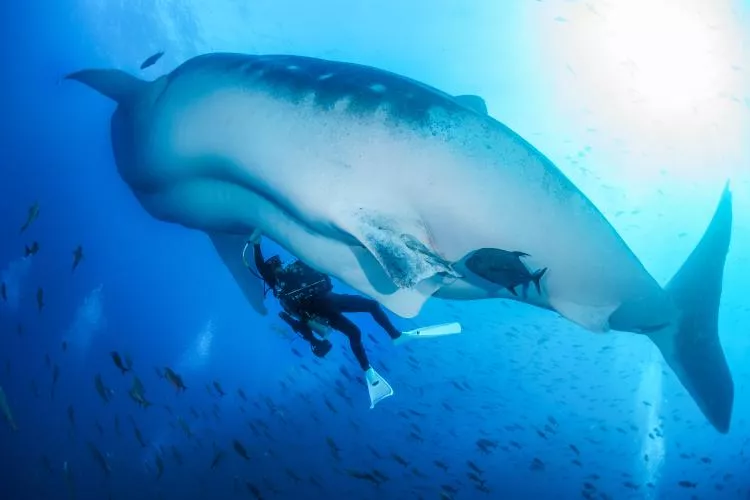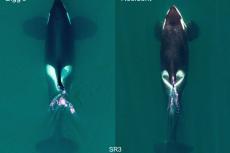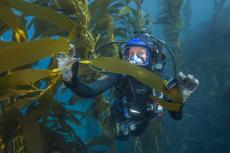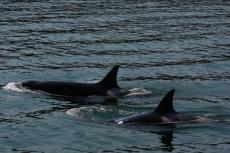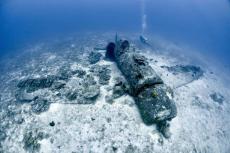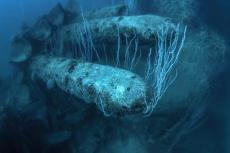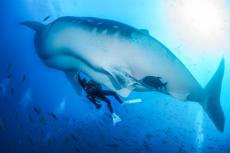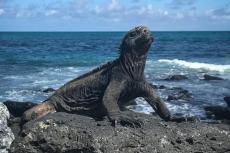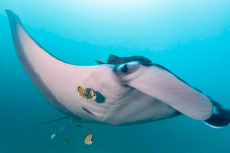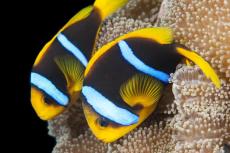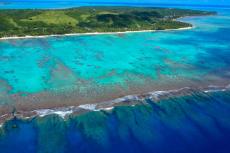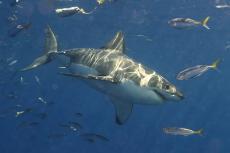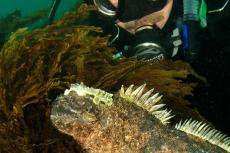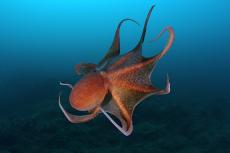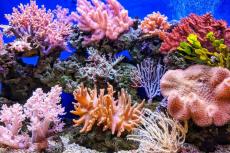Studying wild whale sharks in the Galapagos with underwater ultrasound and blood sampling
In a world-first, underwater ultrasound and blood sampling have been used successfully on wild free-swimming whale sharks in the Galapagos to observe their reproductive states. Don Silcock interviews Dr Simon Pierce of the Marine Megafauna Foundation to learn more about this ground-breaking research.
- Video file
(VIDEO: Researcher Al Dove collecting a blood sample. Video by Dr Simon Pierce)
DS: What were some of the challenges encountered when doing underwater ultrasounds? How did the team overcome them?
SP: These techniques were quite challenging to apply. First of all, we were working at 10 to 30m beneath the surface, often in strong currents. Secondly, whale sharks are wonderfully placid, but they are a lot faster than us, and emerge from the blue with little warning; we only got a short time to work with each animal. The ultrasound unit was the size of a large briefcase, so it was far from hydrodynamic. Rui Matsumoto, the lead author of the study, was using a “jetpack” (actually an underwater propeller mounted on his air tank) to keep up with the sharks and scan them with the ultrasound wand. I felt cool by general association.
Interpretation of the scans requires a lot of experience, too. Rui was filming the process with a GoPro so that we could synchronise the ultrasound imagery with the position on the shark. Kiyomi Murakumo has been examining underwater ultrasound imagery in captive sharks and rays in the Okinawa Churaumi Aquarium for years now, monitoring pregnancy in species from nurse sharks to manta rays, and she was able to discern the developing follicles in these greyscale images that prove that these female whale sharks were indeed adults—something that was previously only possible through dissections.
Collecting blood samples from free-swimming sharks was, similarly, something that had taken a lot of trial and error to get right. Whale sharks have extremely thick skin, so we could not reach their actual veins—instead, we were trying to draw blood from vascularised tissue on their fins. That generally only works on relaxed sharks, and required a large dose of luck! We also had to avoid contamination from seawater, which necessitated the development of a two-syringe system, with one creating an initial vacuum, enabling the second to draw pure blood.
DS: Why do we know so little about whale shark reproduction when they have been kept in captivity for a while now and are considered an “iconic” shark species?
SP: Whale sharks are a relatively well-studied shark, but “relative” is still the key word here. Only one pregnant female, caught in a Taiwanese fishery way back in 1995, has ever been examined by scientists—and we don’t know where the babies live, either. It is mostly juvenile male sharks that frequent coastal areas and tourist sites. Females, both juveniles and adults, probably live offshore, where they are difficult to find, let alone study.
There are a few whale sharks in some large aquaria such as the Okinawa Churaumi Aquarium and Georgia Aquarium, but no adult females. The Okinawa aquarium has a very sexually frustrated adult male whale shark, which matured in their facility, but females probably do not become adults until they are over 30 years old, so it might have to continue waiting for a while longer.
DS: Why did the team choose the Galapagos to do this research over other whale shark hot spots?
SP: Darwin Island in the Galapagos, where this research was conducted, is one of the only places where adult female whale sharks are consistently seen. Between June and October each year, there is a good chance to see them swimming by. The Galapagos Whale Shark Project team has huge expertise in this area, so it was a great opportunity to test and refine these new techniques.
DS: How does this technological technique help scientists understand the physiology of whale sharks—and can it help other vulnerable shark species?
SP: Shark biology studies used to be based on dissections. For endangered species like the whale shark, where we are doing everything possible to keep them alive, that has made us quite creative in the development and application of new techniques, such as underwater ultrasound and in-water blood sampling. Now, we can start investigating their reproduction while they are in the wild—and it will allow for other studies too, such as looking at stress or pollution levels in their populations, which really improves our understanding of their conservation needs.
Whale sharks are gentle giants, so they are lovely animals to work with, and have become a bit of a “poster species” for the use of new techniques, like photo-identification and laser photogrammetry, that are then adapted for other endangered sharks and rays. Other groups are already starting to use underwater ultrasound wands on poles to scan tiger sharks while they swim by. It is going to unlock a lot of new opportunities for minimally invasive research that can give us a wealth of information while avoiding any harm to the animals. It has been a super exciting project to be part of! ■
For more information, see the paper, “Underwater ultrasonography and blood sampling provide the first observations of reproductive biology in free-swimming whale sharks,” by Rui Matsumoto, et al, at: int-res.com/prepress/n01226.html
Dr Simon Pierce is a co-founder of the Marine Megafauna Foundation (MMF) and leads its flagship global research program on whale sharks. His work on the population ecology and management of this iconic species has made him the world’s top whale shark conservation biologist.
MMF’s mission is to save threatened marine life using pioneering research, education, and sustainable conservation solutions. Their goal is a world in which marine life and humans thrive together.
Don Silcock is an underwater photographer and photojournalist based on the island of Bali in Indonesia. His website has extensive location guides, articles and images on some of the best diving locations in the Indo-Pacific region. Go to: indopacificimages.com


